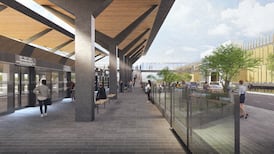At the unveiling of the Spire on Dublin’s O’Connell Street in January 2003, Irish architect Sam Stephenson is quoted as describing it as “elegance and style with none of Nelson’s bulk or baggage”.
However, the British architect behind “the Stiletto in the Ghetto”, Ian Ritchie, recalls for most people 20 years ago the Spire was “slightly off the wall”.
“People couldn’t understand it, they didn’t seem to have an instant narrative or text they could grasp, probably, but it was based on my own feelings about Ireland,” says Ritchie.
“The whole point was it was a monument to how you feel. My feeling was that the sky and the climate of Ireland was exceptional, always changing and it’s quite rare to see a sky like that, there’s nowhere else in the world.”
READ MORE
The 120m spire, which came at a cost of €4.6 million, was unveiled to Dubliners on January 21st, 2003. Originally planned to coincide with the Millennium celebrations, its development was delayed due to a High Court challenge.
0 of 29
To mark the event, a capsule was buried at the foot of the Spire, with items including the front page of an edition of The Irish Times, a till receipt from the bar in the Shelbourne Hotel and a packet of 20 cigarettes.
Ritchie’s design had been chosen as part of then Dublin Corporation’s Millennium monument competition and was supposed to be the first phase of the rejuvenation of a dilapidated O’Connell Street.
There was a need for a new focal point at the site where Nelson’s Pillar – the monument to British admiral Horatio Nelson – had stood from 1809 until 1966, when it was bombed by republicans.
Liam Sutcliffe, who claimed he was responsible for blowing up the pillar, told The Irish Times in January 2003 that its replacement was “absolutely fabulous”.
“It looks like a great engineering job and a much better thing to have on the main street than an old foreign admiral with a broken arm and a missing leg,” he said.
Today, Ritchie says the Spire remains “one of the most audacious things I have ever done or tried to do”.
“I’m very proud of it and I think it will stand the test of time, without doubt,” he says.
“One or two taxi drivers taking me through the city centre over the years have said ‘oh, you designed that bloody thing, did you’, then there’s a couple who would say ‘good on you’.”
Labour councillor Dermot Lacey, who was the lord mayor at the time of the Spire’s unveiling, says he was one of 11 councillors who voted against it.
“I think I’ve become loyal to it, if that doesn’t sound strange,” he says today. “It was the best of the entries but I remember thinking at the time that the entries were awful. There was really very little imagination in it at all but it was the best of them.
“From what I remember the reaction from people around the time of the unveiling was pretty positive. There was a popular chant people used to sing at the time: ‘I can see Clerys now, the cranes have gone.’”
Lacey says what disappoints him most 20 years on is that the Spire was “really meant to be the kick-start for the rejuvenation of O’Connell Street and we still haven’t got there”.
“The reopening of Clerys in the next couple of weeks I think is going to be a really important development, but there is an issue that people are afraid to go into town,” he says.
“I actually don’t always think that’s merited but fear is perception, and they have that perception, so the issue of policing is important… People had a pride in O’Connell Street, but they now have a disappointment with the street and I think they’re right to be disappointed.
“I think the combination of national government interference and the weakness of local government has conspired to us not being able to finish the job, but there still is a job to do.”
Ray Yeates, city arts officer with Dublin City Council, says he doesn’t believe there has ever been a piece of public art that was “universally welcomed straight away”.
“There will always be this wonderful disagreement in the public as to what is it – ‘do I like it?’ – and I think that’s part of our responses to art in general, particularly in the public domain,” he says.
The Spire, he points out, is “really well constructed, it’s remarkably vandal-proof for a piece of public art. It also squared a circle about replacing political monuments with something contemporary... That’s a big achievement.
“It doesn’t matter if you like it or not, it’s an incredibly impressive piece, you stand back and say, wow, it took courage to propose that.”





























